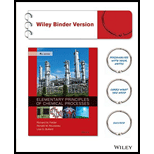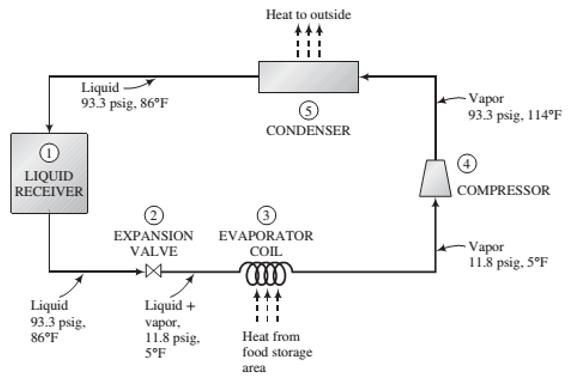
The following diagram shows a simpli?ed version of how a refrigerator works:

In a liquid receiver 1, a liquid refrigerant (any one of a number of halogenated hydrocarbons such as CCl2F3) is contained at high pressure and temperature. The liquid passes through an expansion valve 2, where it ?ashes to a low pressure, cooling to its boiling point at this pressure and partially evaporating. The liquid—vap0r mixture passes though an evaporator coil 3. Air from the food storage area circulates over the coil, and the heat absorbed by the evaporating refrigerant in the coil causes the air to cool. The cold refrigerant vapor emerging from the coil passes to a compressor 4, where it is brought back to a high pressure and in the process is raised to a high temperature. The hot vapor then passes through a condenser 5, where it is cooled and condensed at constant pressure. The air that absorbs the heat given up by the condensing ?uid is discharged outside the refrigerator, and the lique?ed refrigerant returns to the liquid receiver.
Suppose Refrigerant R−12 (the standard name for CCI2F2 undergoes this cycle at a circulation rate of 40 lbm/min, with the temperatures and pressures at the different points of the cycle being those shown on the ?ow diagram.
Saturated Fluid: 
Superheated Vapor: 
(a) Suppose the expansion valve operates adiabatically and  is negligible. Use an energy balance about the valve to calculate the fraction of the refrigerant that evaporates in this stage of the process.
is negligible. Use an energy balance about the valve to calculate the fraction of the refrigerant that evaporates in this stage of the process.
(b) Calculate the rate in Btu/min at which heat is transferred to the refrigerant that evaporates in the coil. (This is the useful cooling done in the system.)
(e) lf the heat loss in the condenser is 2500 Btu/min, how much horsepower must the compressor deliver to the system? (Use an overall energy balance to solve this problem.)
(d) You have just given a “What do engineers do?" talk at a middle-school career day, and one of the students in the audience asks if you can explain how a refrigerator works. Try to do it in terms that a bright l2-year-old student could understand.
(e) The manufacture of R−12 in the United States was banned as a result of the Montreal Protocol. Why?
Want to see the full answer?
Check out a sample textbook solution
Chapter 7 Solutions
Elementary Principles of Chemical Processes, Binder Ready Version
Additional Engineering Textbook Solutions
Elements of Chemical Reaction Engineering (5th Edition) (Prentice Hall International Series in the Physical and Chemical Engineering Sciences)
Process Dynamics and Control, 4e
Fundamentals of Applied Electromagnetics (7th Edition)
Mechanics of Materials (10th Edition)
Software Engineering (10th Edition)
Data Mining for Business Analytics: Concepts, Techniques, and Applications with XLMiner
 Introduction to Chemical Engineering Thermodynami...Chemical EngineeringISBN:9781259696527Author:J.M. Smith Termodinamica en ingenieria quimica, Hendrick C Van Ness, Michael Abbott, Mark SwihartPublisher:McGraw-Hill Education
Introduction to Chemical Engineering Thermodynami...Chemical EngineeringISBN:9781259696527Author:J.M. Smith Termodinamica en ingenieria quimica, Hendrick C Van Ness, Michael Abbott, Mark SwihartPublisher:McGraw-Hill Education Elementary Principles of Chemical Processes, Bind...Chemical EngineeringISBN:9781118431221Author:Richard M. Felder, Ronald W. Rousseau, Lisa G. BullardPublisher:WILEY
Elementary Principles of Chemical Processes, Bind...Chemical EngineeringISBN:9781118431221Author:Richard M. Felder, Ronald W. Rousseau, Lisa G. BullardPublisher:WILEY Elements of Chemical Reaction Engineering (5th Ed...Chemical EngineeringISBN:9780133887518Author:H. Scott FoglerPublisher:Prentice Hall
Elements of Chemical Reaction Engineering (5th Ed...Chemical EngineeringISBN:9780133887518Author:H. Scott FoglerPublisher:Prentice Hall
 Industrial Plastics: Theory and ApplicationsChemical EngineeringISBN:9781285061238Author:Lokensgard, ErikPublisher:Delmar Cengage Learning
Industrial Plastics: Theory and ApplicationsChemical EngineeringISBN:9781285061238Author:Lokensgard, ErikPublisher:Delmar Cengage Learning Unit Operations of Chemical EngineeringChemical EngineeringISBN:9780072848236Author:Warren McCabe, Julian C. Smith, Peter HarriottPublisher:McGraw-Hill Companies, The
Unit Operations of Chemical EngineeringChemical EngineeringISBN:9780072848236Author:Warren McCabe, Julian C. Smith, Peter HarriottPublisher:McGraw-Hill Companies, The





